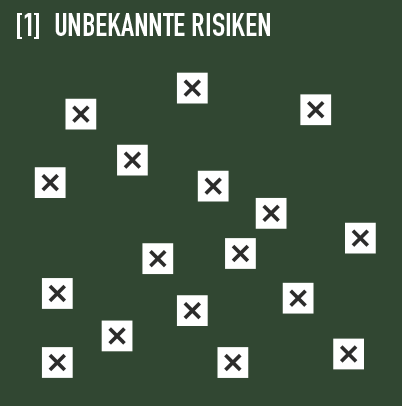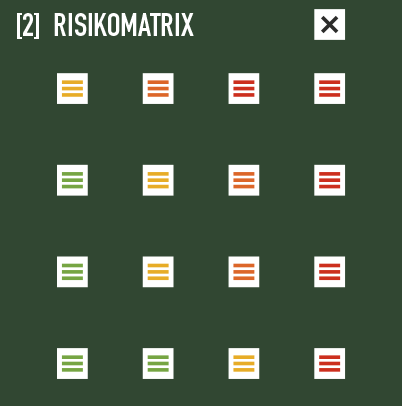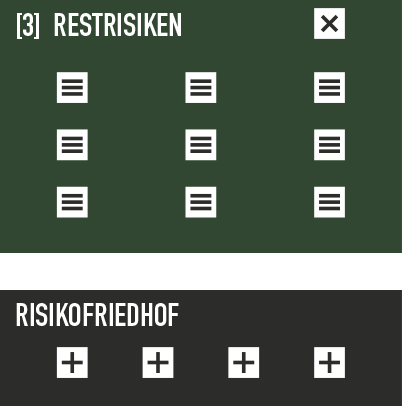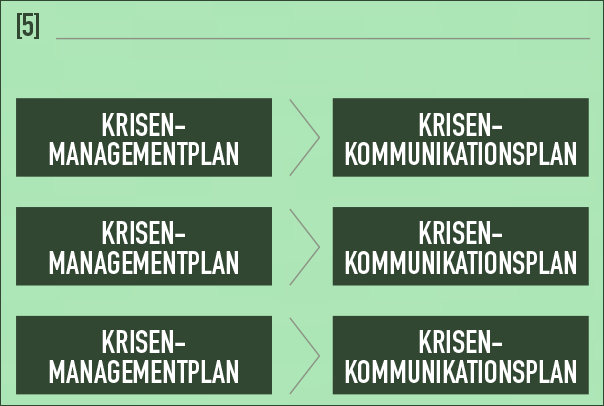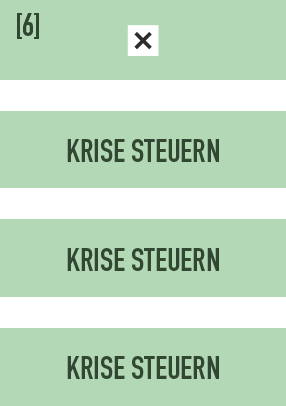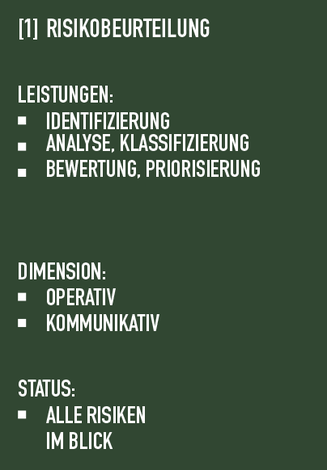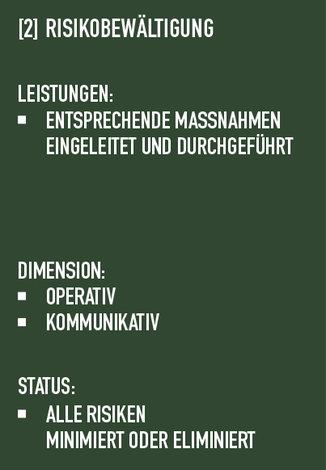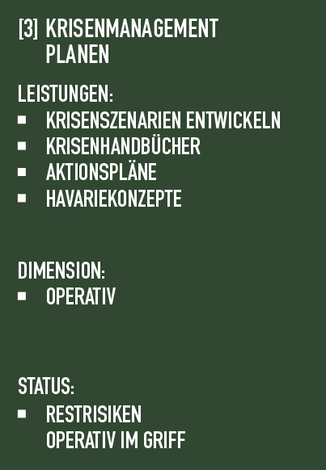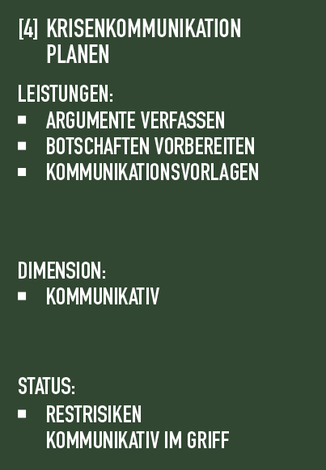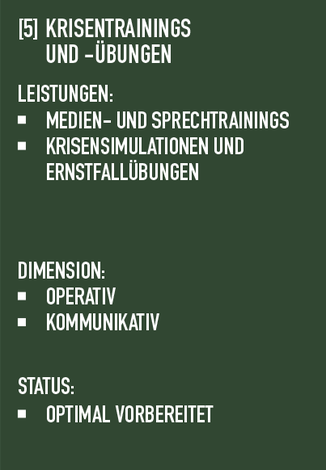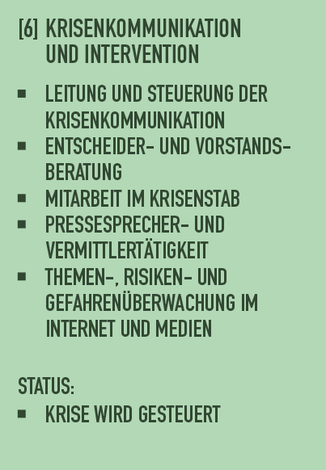Phase 1: Risikobeurteilung und -bewältigung
[1] Unbekannte Risiken
Jedes Unternehmen birgt Gefahren, auch Ihres.
Besser Sie kennen die Risiken genau.
So haben Sie höhere Chancen, sicher und erfolgreich Ihre Unternehmensziele zu erreichen.
[2] Risikomatrix
Alle Risiken werden systematisch identifiziert, analysiert, bewertet.
Die höchsten Risiken müssen als Erstes angegangen werden.
[3] Restrisiken
Nach unserer Risikobeurteilung und der Umsetzung der entsprechenden Maßnahmen bleibt für Sie eine überschaubare Anzahl von minimierten Restrisiken bestehen.
Aus diesem Vorteil muss jetzt eine handfeste Vorbereitung hervorgehen.
Phase 2: Sensible Krisenprävention
[4] Restrisiken
Jetzt gilt es, jedes einzelne Restrisiko gezielt anzugreifen.
[5] Wir entwickeln ein individuelles Krisenmanagement und Krisenkommunikation für jedes einzelne Krisenszenario
Das bedeutet: Strategie planen, Argumente und Botschaften verfassen, Interviews, Pressekonferenzen und Kreuzverhöre trainieren und Abläufe einstudieren.
[6] Im Krisenfall wird die Situation souverän gesteuert
Selbst wenn dann noch ein unerwartetes Risiko auftritt, steht Ihnen hierfür eigens ein Krisenmanagement- und -kommunikationsprozedere zur Verfügung.
[1] Risikobeurteilung
- Vorbereitung: Wir erstellen zugespitzt auf Ihr Unternehmen ein Briefing-Papier und für jeden Unternehmensbereich Fragebögen.
- Einzeltermine mit Unternehmensführung, Management, Kommunikationsleitung
- Interviews und Workshops
- Risikobeurteilung: das gesamte Reputationsrisiko unter Berücksichtigung aller kommunikativen und operativen Aspekte
- Das Ergebnis: alle Risiken im Blick
- Viele Gefahren für Unternehmen lauern etwa auf dem zunehmend relevanten Gebiet der Compliance. Risiken finden und bearbeiten wir mit Ihnen durch Abgleich des juristischen Soll- und Istzustands. Im Gesundheitswesen sind wir dazu Partner des Angebots Smart_Compliance_Consulting
[2] Risikobewältigung
- Wir präsentieren der Unternehmensführung Analyseergebnisse und Empfehlungen.
- Risikobewältigung: entsprechende Korrekturen einleiten und durchführen
- Gloria Mundi unterstützt Sie und alle Verantwortlichen bei der Umsetzung unserer Empfehlungen.
- Das Ergebnis: alle relevanten Risiken minimiert oder eliminiert
[3] Planung des Krisenmanagements
- Restrisiken: individuell entwickelte Krisenszenarien durchspielen
- für jede dieser Situationen Krisenhandbücher, Aktionspläne und Havariekonzepte erarbeiten
- Das Ergebnis: Jedes Restrisiko ist dann operativ im Griff.
[4] Planung der Krisenkommunikation
- die begleitende Krisenkommunikation zu jedem möglichen Krisenfall planen
- Strategie festlegen, Argumente verfassen, Botschaften vorbereiten, griffbereit und systematisch ablegen
- Kommunikationsvorlagen mit sauberem juristischen Hintergrund
- Stärkung der gesamten unternehmerischen Kapazitäten, in der Krise schnell, klar und schlüssig zu kommunizieren
- Das Ergebnis: Jedes Restrisiko ist auch kommunikativ im Griff.
[5] Krisentrainings und -übungen
- Medien und Sprechtrainings
- Krisensimulationen und Ernstfallübungen
- Sie wissen vor der Krise, was Sie in der Krise sagen werden. Und das – egal wer für Ihr Haus spricht – dann mit einer Stimme.
[6] Im Krisenfall: Krisenkommunikation und Intervention
- Im Ernstfall wird die Krise souverän gesteuert.
- Sie holen die Pläne für genau diese Situation aus der Schublade und wissen, was zu tun ist.
- Es genügen dann konkrete tagesaktuelle Adaptierungen.
- Zusätzlich stehen wir Ihnen als vertrauter Verbündeter zur Seite, falls Sie das möchten: für die Leitung und Steuerung der Krisenkommunikation, die Entscheider und Vorstandsberatung, als Mitarbeiter im Krisenstab, in der Themen und Gefahrenüberwachung.
[KP.III.]
Krisenprävention: unser Ansatz
Friedenszeiten klug nutzen
Die Risiken im Griff, nicht nur im Blick
Ihre Risiken im Blick zu haben, ist die eine Sache. Sie aber auch im Griff zu haben, ist eine ganz andere. Der Unterschied ist entscheidend. Das Erste macht Sie risikobewusst, raubt Ihnen aber auch bisweilen den Schlaf. Das Zweite macht Sie sicher und Ihre Nächte wieder ruhig. Vor allem dann, wenn es darauf ankommt: in Ernstfall und Ausnahmezustand.
Bringen wir es auf den Punkt: Der Ansatz des Risikomanagements reicht in vielen Unternehmen und Institutionen nicht weit genug. Es ist unbefriedigend, wenn nur Risiken aufgezeigt und allenfalls zum Teil reduziert werden. Im Krisenfall bleibt man trotzdem unvorbereitet, wenn Kritiker Druck aufbauen, wenn Kameras vor dem Werkstor laufen, wenn Bürger besorgt anrufen und, und, und. Welches Unternehmen will und kann sich das erlauben?
Die meisten Geschäftsführer und verantwortlichen Entscheider wollen wissen, dass man optimal und zu jeder Zeit vorbereitet ist. Was sie nicht wollen, ist, viel und ständig darüber nachdenken zu müssen.
Handfest auf den Ernstfall vorbereitet
Was den meisten Unternehmen fehlt, ist die handfeste Vorbereitung auf den Ernstfall. Wir entwickeln zu jedem möglichen Risiko und Krisenszenario den individuellen Aktionsplan, die begleitende Krisenkommunikation und üben in Trainings die jeweiligen Ernstfälle – realistisch simuliert. Die unternehmerische Wahrnehmung kann nicht auf Verteidigung und Vorsorge eingefroren oder dauerhaft auf Defensive und Gefahrenbewusstsein getrimmt werden – das sogenannte risikobasierte Denken. Unternehmer sein heißt auch wagen. Das Ziel ist daher nicht das Kleinhalten von Risiken oder Gefahren, sondern das Großmachen Ihres Unternehmens. Geschäftsführer und Letztverantwortliche wollen aktive und praktikable Sicherheit.
[K.IV.]
Umgang mit Risiken wird zur Pflicht: die ISO 9001:2015
Die ISO 9001 ist eine Qualitätsmanagementnorm der Internationalen Organisation für Normung (ISO). Die überarbeitete Fassung ISO 9001:2015 fordert neuerdings ausdrücklich die Berücksichtigung relevanter Risiken von den zertifizierten Unternehmen. Das heißt, ab 2017 müssen für die ISO-Zertifizierung geeignete Maßnahmen zur Risikobeurteilung und -bewältigung vorgewiesen werden. Die Anforderungen der Norm an das dafür erforderliche Risikomanagement sind vage gefasst. Entsprechend variieren die Tiefe und der Umfang des jeweiligen Risikomanagements von Unternehmen zu Unternehmen. Es ist Entscheidung der Geschäftsführung, wie stark man in diese Pflicht investieren möchte und wie effektiv ein solches System dann tatsächlich sein kann.
Das Risikomanagement gilt für ein Unternehmen – ob ISO-zertifiziert oder nicht – heute als unverzichtbar. Auch wenn das Risikomanagement effektiv nur ein erster Schritt ist. Falls Ihr Unternehmen noch kein Risikomanagement hat, dann setzen wir mit unserer Krisenprävention bei der Risikobeurteilung an. Falls aber ein Risikomanagement – z.B. dank einer bestehenden ISO-Zertifizierung – bereits existiert, suchen wir die nahtlose Kooperation mit Ihrem bestehenden Risikomanagement und bauen unsere Vorbereitungsleistungen darauf auf.
Investieren Sie mit maximalem Nutzen
Das Thema wird augenscheinlich jeden Tag wichtiger. Die Risikomanagementanforderungen in der ISO-Revision 2015 spiegeln diese Entwicklung wider. Investieren Sie so, dass Ihr Unternehmen den maximalen – und d.h. den eigentlichen – Nutzen daraus ziehen kann: vorbereitet sein im Krisenfall. Als Experten für Krisenmanagement und -kommunikation machen wir Sie für den Ernstfall sattelfest. Wir packen mit Ihnen entschieden und gekonnt Ihre Risiken an. Nehmen Sie unsere sensible Krisenprävention in Anspruch; Sie werden noch besser schlafen können. Wir unterstützen Sie in Friedenszeiten mit einer verlässlichen und tauglichen Ernstfallvorbereitung. Damit steht Ihr erster Verbündeter schon mal fest.
[KP.V.]
Leitfaden sensible Krisenprävention
Kein Unternehmen kann sich leisten, im Ernstfall unvorbereitet zu sein. Bereiten Sie sich deshalb schon in Friedenszeiten auf diesen Ausnahmezustand vor und erkennen Sie, wo und wie Ihr Angebot krisengefährdet ist und was dagegen zu tun ist. Wie Sie dabei am besten vorgehen, haben wir in einem Leitfaden zur Krisenprävention beschrieben.
